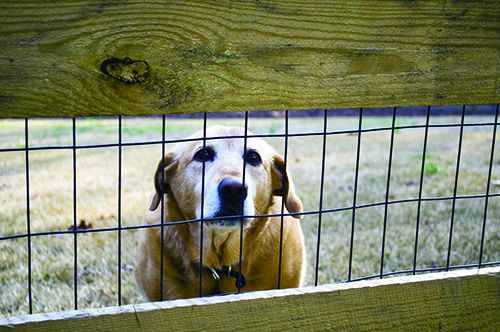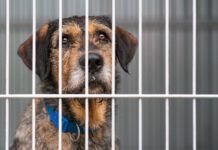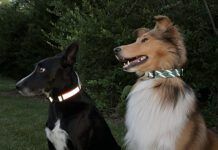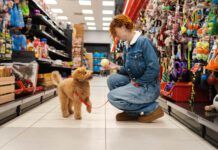Given the sensible advice to socially distance, what better time to create a safe, at-home haven for your dog? Here are five ways you can increase your dog’s (and your own!) enjoyment of your yard.
1. Invest in a good fence. A secure fence is the most critical element of a safe place for your dog to potty, play, train, and just hang out. Sometimes a dog owner will tell me, “We don’t need a fenced yard; we have a large property for the dog to run on.” I explain that while my husband and I live on about 300 acres, we have fenced a much smaller area next to our home so we have an absolutely safe place for them to be outdoors without supervision.
What type of fence? There are many to choose from, including chain link or other wire fencing, wood, composite, or plastic. It’s up to your budget, your aesthetic preferences, your location (homeowner’s associations may limit your options), and your dog.
Why do I include “your dog” on the list of factors that will affect your choice of fencing? The height of the fence is most obvious; if you have small dogs, you may not need a six-foot fence. But if you’ve got leggy dogs known for their interest in chasing game (ahem, hounds), a six-foot fence might not be secure without an inwardly angled section or “coyote rollers” at the top.
Height isn’t all there is to it, however. Some dogs enjoy their ability to see through a wire fence, and never get excited by passersby on bikes, skateboards, or on foot. Other dogs might lose their minds when faced with this much stimuli. Also, if there are dogs next door, their presence and/or behavior on the other side of the fence may be frustrating for your dog. In these instances, a solid privacy fence may be advisable.
If your dog is a digger, you may need to bury wire fencing along your fence line, or build the fence on a concrete pad or path. Digging out may not occur to some dogs ever, but others may detect any sign of light under the fence and get to work digging out immediately!
Think carefully about the type of gate that is used to access the area. It should be easy for you to open (especially when you have only one hand free, with a leash in the other) but not at all easy for your dog to open.
Note that when I say fence, I do mean a real, physical fence. Electric fences (a.k.a. “shock fences”) may keep your dog in but can’t keep other animals out – that is, critters who could harm your pet, aggressive stray dogs, or even a human who could steal or harass your dog).
Also, if your dog is motivated sufficiently to chase something, she could go through and then likely would not return, scared to try to cross the boundary now that she’s not overstimulated by chasing something.
Last but not least, a dog that gets zapped for coming close to the boundary to investigate a passing jogger, bicyclist, or other dog is likely to begin to associate those with punishment and may develop fear and/or aggression related to those previously neutral stimuli.
Need more convincing? See these past WDJ articles:
• “Pros & Cons of Electric Underground Fences,” 5/2001
2. Consider the flora. Are there parts of your yard that you don’t want to be disturbed? In this case, a lower level of decorative fencing may make the most sense – and keep you from tensing up every time you see your dog approach your award-winning roses or dahlias.
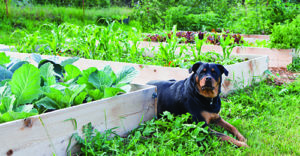
A couple of our dogs used to enjoy raiding the vegetable garden just when the cucumbers or strawberries ripened! That made me smile so I made no effort to cordon off the area.
If you haven’t already planted a garden, consider your dog’s current pattern of uses before planting. Note where your dog spends the most time so you can design accordingly; don’t put plants where he’s created well-worn patrol paths, for example. Consider sacrificing those areas and putting down some river rock, permeable pavers, sand, or bark mulch.
When choosing plants for your yard, keep in mind that many of the options found in your local garden supply stores can be toxic for your dog. One that is distressingly common to see is the sago palm; just a few nibbles on the leaves or roots of this plant can cause liver damage and even death. For an exhaustive list of plants that are toxic and non-toxic to dogs, see the ASPCA’s website: aspca.org/pet-care/animal-poison-control/dogs-plant-list.
Don’t forget to research the mulch you are considering for use in your yard; mulch made from cocoa beans, in particular, is toxic for our canine friends!
3. Designate a potty spot and train your dog to use it. You’ll thank me later for this one. Even if you’ve had your dog or puppy for a while, it’s worthwhile to spend the time to teach him to potty in the same area. This saves time when you’re cleaning up (no hunting for the poop in the dark or rain) – and prevents squishy surprises!
Some people want their dog’s potty area to be located close to the house for quick access; others might want it to be hidden from view of the places in the yard where you spend time. Either way, make sure it’s in reach of a hose. An area that is layered with at least three inches of 3 absorbent sand, covered with pea gravel or small river rock, will be easy to keep clean and odor-free with an occasional hosing.
To teach your dog or puppy to use the potty, pretend you are starting house-training all over again. Accompany your pup on leash to this area several times a day and handsomely reward him or her upon elimination until this habit is deeply ingrained. Be sure to pick up the poop and hose down the area regularly.
4. Add enriching “playground” equipment. Our yards should be about more than just containing our dogs; ideally, they are also a super fun place to play with our dogs and to let them play.

Many dogs like to climb or to have a raised platform of some kind where they can survey their terrain (obviously, away from the fence). My Boxer-mix, Petey (seen above), loves to hang out on a homemade A-frame we built out of scrap lumber and covered with artificial grass carpet. Make sure to apply something to prevent slipping – whether you paint the surface with a paint to which sand has been added, or you apply rubber or sand-textured non-slip adhesive-backed strips.
A recent WDJ article (“The Play Way,” June 2020) promoted the power of play to help fearful dogs gain confidence. Our family’s new addition, a rough-coated Jack Russell Terrier, Archie, had very little socialization during his first year of life and is fairly fearful. We engage him in tug, chase, and fetch play sessions in the house, but Archie is also enjoying climbing and playing on the A-frame. We are seeing a new dog emerging!
I recently took Petey to a friend’s home where she has fenced about an acre for her dogs. Petey thoroughly enjoyed this space, not only for its size, but also because they had left many natural features like tree stumps and boulders for the dogs to explore and look for varmints. Consider leaving some natural features in your yard for your dog to sniff and hunt.
One of the most enriching things you can add to any dog’s yard is a digging box – a place where they can dig to their heart’s content, without getting in trouble! You can buy a child’s sandbox or build a basic frame, fill it with sand, and hide some doggy toys and bones for your pooch to seek out. In hot weather, keep the sand wet, and in no time at all, you’ll find your dog hunkered down in a freshly dug, cool, damp hole.
Most dogs will also appreciate a variety of lounging surfaces – lush grass, cool (or warm, depending on the season) concrete, and perhaps a raised cot-style bed – and move from one surface to the other throughout the day.
I’m a huge fan of allowing compatible dogs to play together – but not at all a fan of dog parks. Not every dog at a public park is playful, and not every owner is super attentive, able to read their dog’s body language, and ready to intervene to keep the peace. A better alternative, if you have a playful, social dog and a secure yard, is to create your own mini dog park. Help your dog cultivate friendships with dogs who have a similar play style and set up play dates with their owners!
A safely fenced yard is also a fantastic place to train your dog! Inside your home is the best place to start training new behaviors to keep the distraction level low, but as your dog gains competence, take the practice out into your fenced yard. The distraction level outdoors will be just a bit higher, but not as high as the wider outside world. Practice there until his responses to your cues are solid; only then should you practice his new behaviors in the face of even more distractions.
A fun and safe dog yard is a beautiful thing – and for some of my elderly or handicapped dog-training clients, given their strength and mobility issues, a required tool for giving their dogs a chance to potty, exercise, and relax outdoors. Design yours so it meets your and your dog’s needs and have a blast!
5. Install yard lights so you can visually scan for critters, or go out with your dog and check the yard before every night-time potty excursion. How many of you have a dog who got skunked when you put him out for a late-night potty? I’d guess a pretty high percentage of us have experienced this, whether we live in the country or a suburb.
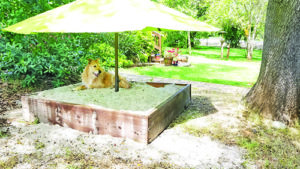
Skunks aren’t the only type of animal to look out for before allowing your dog to enter the yard at night, however. Depending on where you live, your yard just may be visited at night by a fox, raccoon, coyote, bobcat, badger, mountain lion, or bear. Turning on a light before sending your dog outside will send most of these animals back over the fence and keep your dog safe.
The tendency of dogs to chase anything perceived as prey – deer, bunnies, stray cats, etc. – is another reason to check the yard each time before you allow your dog out there. Turning on the lights and clapping your hands can warn any critters that they have just a few seconds to vamoose!
Author Helene Goldberger, Esq., PMCT, CPDT-KA, is an attorney in Albany, NY, who has been a professional dog trainer for six years (Heartdog Training). She is also a certified canine massage practitioner. See page 24 for contact information.


